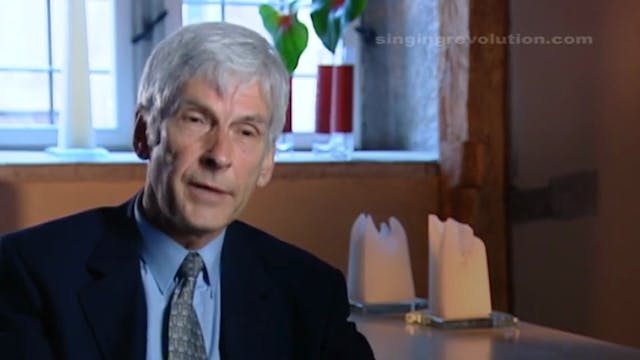The Singing Revolution Educational Content
A bundle of 20 short educational videos relating to The Singing Revolution. Includes over 5 hours of additional footage, interviews, and historical videos.
-
Comments on the Atlantic Charter/Yalta/Hungarian Uprising
Learn the chilling details regarding the post World War II Realpolitik decisions of the Allies that left the Baltic Countries, and later Hungary, victims of a brutal Soviet occupation.
-
Estonians Fleeing Stalin – Waiting to Return
Hear the stories of two people whose parents fled Stalin with them as small children, both of whom ended up in the United States. How did Estonians who stayed behind in Estonia feel about the many refugees?
-
Deportation Stories – Mari-Ann Kelam
Hear an overview regarding the Soviet deportations of an estimated 8%-14% of the Baltic Countries.
-
Deportation Stories – Enn Sarv
Enn Sarv resisted both the German occupation and the Soviet occupation. As a result, he was imprisoned first in a German Concentration Camp. Then, after the war, he came home and subsequently was arrested by the in Soviets and sent to the Gulag. His fiancée waited for him all that time.
-
Deportation Stories – Heiki Ahonen
Heiki Ahonen’s parents met while both were imprisoned in Soviet Labor Camps in the 1940s. He shares their story. Due to this history of his parents, Heiki was a marked man to the Soviets and was arrested himself in 1983 due to his anti-Soviet activities.
-
Deportation Stories - Heino Noor
Heino Noor was imprisoned simply because his parents were put into Labor Camps because they had been in the Estonian Army. Heino’s mother was executed by gunshot while at the camp. In 1991, after Estonia regained its independence, Heino learned the name and address of his mother’s executioner. ...
-
Deportation Stories – Tiia-Ester Loitme
Tiia-Ester Loitme is featured in The Singing Revolution, and her story of being sent to the Gulag at age 14 is covered in the film. Learn more about how she survived and became a noted Estonian choir conductor. Since 1989, she has been chief conductor of the Grammy Award-winning choir Ellerhein.
-
Deportation Stories – Matti Päts
Matti Päts is the grandson of Estonian President Konstantin Päts. When the Soviets occupied Estonia in 1939, President Päts, his children and grandchildren became the second family to be deported to the Gulag (the first being Estonian Army General Laidoner’s family). At 8 years old, Matti was s...
-
Forest Brother Alfred Käärmann
Alfred Käärmann fought the Soviets as a Forest Brother from 1944 – 1952. He was captured and sent to Soviet prison. He was released in 1967. But he was constantly harassed by the Soviets until Estonian independence in 1991. Hear his full, powerful story.
-
The Role of Finnish TV, Voice of America & Radio Free Europe
Truth was hard to come by in the Soviet Union. The government controlled all sources of information, and used those pipelines to endorse itself. Due to their geographical location, Estonians in the north could access Finnish TV for a window on the West. Voice of America and Radio Free Europe a...
-
Comments from Trivimi Velliiste: The Acorn Book Club
Learning how to camouflage plans for independence from the Soviet authorities became a masterful art form in Estonia. The Acorn Book Club is a great example. In the 1970s the Soviets announced plans to fight illiteracy. Freedom-minded Estonians formed a “book club” under the guise of fighting ...
-
Estonian Dissidents
Learn how Soviet dissidents functioned, what motivated them and what they were thinking.
-
Soviet Education and Youth
Hear about the conflicting lessons of history Estonian children learned at home compared to what they heard at school. Hear the full story of a teenage rebel being arrested and interrogated by the Soviet Secret Police (the KGB) for simply sporting a Mohawk haircut dyed bright red.
-
Estonian Independence Day
Estonians declared their independence on February 24, 1918. Fifty years of Soviet occupation starting in 1940 never changed the importance and legitimacy of that first “Independence Day”.
-
Details on the 1987 Hirve Park Demonstration
Gorbachev introduced the concept of “Glasnost”, or open discussion of political and social issues. He never dreamed how far Estonians would take that concept. The 1987 Hirve Park demonstration was a bold challenge to the legality of the Soviet occupation. Demands were made to put Stalin’s henc...
-
Comments on the Popular Front
The Popular Front sought change, but not full independence. They felt they were more realistic than those seeking outright independence, and therefore would be more successful. They were hoping for greater freedom within the confines of being part of the Soviet Union. Revolutions, even success...
-
Tunne Kelam on the Citizens Registration
In 1988, over 800,000 Estonians (virtually every adult in the country) signed a petition denying the legality of the Soviet occupation and declaring themselves citizens of the 1939 Republic of Estonia. This led to an election of the “Congress of Estonia” in 1990…done while the Soviets were still...
-
Comments on Gorbachev
Gorbachev is often seen in the West as a freedom-leaning Soviet leader. That is not the view of those who lived under his rule.
-
Role of Culture Under Soviet Occupation
Learn how Shakespeare’s play Hamlet was turned into a message of hope for a free Estonia…right under the eyes of Soviet authorities. When government controls schools, television, radio and the print press, double entendre in the arts becomes a principal pipeline of truth.
-
Comments on the Role of Vaino Valjas
From 1978 until 1988, Estonian’s Communist Party was led by hard-liner Karl Vaino. In 1988, in order to calm down the Estonian hunger for independence, Gorbachev replaced him with native Estonian Vaino Valjas, a childhood friend of Gorbachev’s with a much softer approach than Karl Vaino. Valjas...
-
The Baltic Bloc – MRP Acknowledgment in Moscow
The Molotov-Ribbentrop Pact was an agreement between Nazi Germany and Stalin’s Soviet Union that contained secret protocols turning the Baltic countries (Estonia, Latvia, Lithuania) over to Stalin. For 50 years, the Soviet Union denied that these protocols existed. Hear the story of how they we...
-
Comments on the August 1991 Coup
The Moscow Coup happened in 1991. Tanks rolled into Estonia. Hard-line Soviet occupation was back and no one knew how it would end. We now know the Coup would collapse and Estonia would become a free nation. But how did things seem at that time?
-
The Importance of the Song Festival/Laulupidu
The Estonian Song Festival Laulupidu is a high level artistic event. But it also has been a critical tool for unifying the country…especially during foreign occupation. Hear about the meaning of Laulupidu to Estonians.
-
Interview with filmmakers James and Maureen Tusty
A brief interview with the filmmakers done shortly after the release of the film.
-
Song Festival Performance: Ilus Maa / Beautiful Land
-
Song Festival Performance: Boys Choirs
-
The Singing Revolution - Official Trailer



























